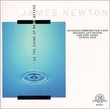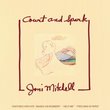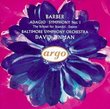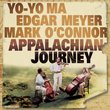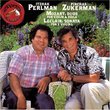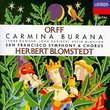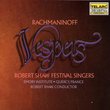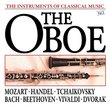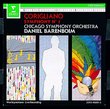| All Artists: Dun Tan, Tan Dun, Imperial Bells Ensemble, Hong Kong Philharmonic Orchestra Title: Tan Dun: Symphony 1997 (Heaven, Earth, Mankind) Members Wishing: 1 Total Copies: 0 Label: Sony Release Date: 7/1/1997 Genre: Classical Style: Symphonies Number of Discs: 1 SwapaCD Credits: 1 UPC: 074646336823 |
Search - Dun Tan, Tan Dun, Imperial Bells Ensemble :: Tan Dun: Symphony 1997 (Heaven, Earth, Mankind)
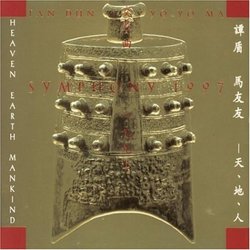 | Dun Tan, Tan Dun, Imperial Bells Ensemble Tan Dun: Symphony 1997 (Heaven, Earth, Mankind) Genre: Classical
|
Larger Image |
CD DetailsSimilar CDsSimilarly Requested CDs
|
CD ReviewsEspecially fine middle section. Karl Henzy | 01/07/1999 (4 out of 5 stars) "I was actually disappointed when I first started listening to this work--I knew Tan from works like Death and Fire and his great opera, Marco Polo, and I knew that his music was more than just a gimmicky mix of Eastern and Western styles. He had a powerful and sometimes frightening imagination, and his music was genuinely avant-garde. Then in the first section of Symphony 1997, "Heaven," we get a rather "nice" collection of tunes, suitable for the occasion of reunification, but not very compelling if you know earlier Tan. Keep listening, though: the middle section, "Earth," is a self-contained concerto (also called Yi-3) for Cello, Bells, and Orchestra. It's powerful and intense, and is really the musical center of the work--the outer sections are more for ceremony. "Earth," though, adds to Tan's growing list of achievements, making him easily one of the mose important composers of the 90s." Unforgettable concert BUT... Philippe COLIN | 08/27/2001 (4 out of 5 stars) "I had the chance to see the occidental premiere of Tan Dun's 'Symphony 1997: Heaven, Earth, Mankind' at the 1998 London Proms, conducted by the composer himself. This is a concert I will never forget. The large scene of the Royal Albert Hall was filled with an impressive number of instruments and performers: in addition to the occidental phiharmonic orchestra, it featured a choir of Chinese children, a bianzhong (ancient Chinese bells) and an ensemble of traditional Asian drums and percussions. The result was pure magic for the open-minded listener. This is why I may have overrated this album, which does not quite deliver the same enchantment as the 'real' thing. This symphony is innovative and skillfully composed but the listener gets lost into this blend of experimental music, traditional Chinese themes and a main theme so trivially easy to remember it sounds like Vangelis... The symphony was commissioned to celebrate the reunification of Hong Kong with China and the middle part (probably the most interesting and experimental) is actually a further development of one of Tan Dun's previous works. My impression is therefore that the symphony could have done with more coherence. Nevertheless, this is a most exciting and original record, well worth buying. And need I mention that Yo-Yo Ma's skill is as stunning as ever?" Music worthy of the event it was commissioned for. Moses Alexander | Alabama, USA | 11/16/2001 (4 out of 5 stars) "Its not everyday that one land mass unifies itself politically with another (in this case Hong Kong becoming a part of China.) With an event of that scale, one certainly requires some big music...music that's big in everyway...joy...sound...size of ensemble...etc.Also considering Hong Kong was passing from British to Chinese rule there needed to be a certain amount of both eastern and western culture involved. Who could have been more perfect than Tan Dun? The ensemble consists of the Hong Kong Philharmonic Orchestra, Imperial Bells Ensemble of China, Yip's Children's Choir and cello soloist Yo-Yo Ma (you can't get a bigger cellist now can you?)The piece opens up with the "Song of Peace" a gorgeous tune sung by children's choir and supported by orchestra. Musically the piece is all over the place, but that's said in a good way...its grand, beautiful, austere, light-hearted and every other emotion that one could feel. The piece is also a cello concerto of sorts often using Ma's cello lines against orchestra, bells, choir, etc. There are musical allusions to Beethoven's 9th Symphony, and I also feel I hear some Debussy as well, but that's always been Tan's formula for success, everything and the kitchen sink, but in a well ordered sort of way.Tan Dun's music can take some getting used to, and this probably isn't the best place to delve into it (my vote for that is "Crouching Tiger, Hidden Dragon" soundtrack or his "Songs from Peony Pavillion.") (You can hear a bit of the main theme of "Crouching Tiger" in part 11 of the Symphony entitled "MANKIND.")A really interesting hodge-podge of stuff for the truly adventurous...and always, Yo-Yo Ma is excellent."
|

 Track Listings (13) - Disc #1
Track Listings (13) - Disc #1